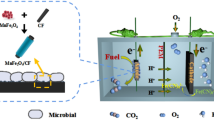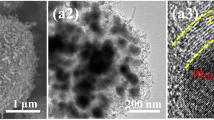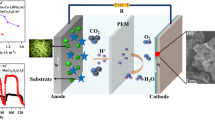Abstract
The novel MnCo2O4 (MCO/CF), CNTs-MnCo2O4 (CNTs-MCO/CF) and MnFe2O4-MnCo2O4 (MFO-MCO/CF) electrodes were prepared on carbon felt (CF) by simple hydrothermal and coating method as anodes for MFC. The modified anodes combine the electrocatalytic properties of transition metal oxides (TMOs), the high electrical conductivity of CNTs and the good biocompatibility of CF. These anodes play a synergistically role in the synthesis of structural, to realize high-efficiency electron transfer, low resistance and sufficient space for microbial colonization, while also ensuring high power density. The maximum power density of the composite electrodes CNTs-MCO/CF and MFO-MCO/CF were 4268 mW/m3 and 3660 mW/m3, respectively. The synergistic effect of multi-component effectively improves the performance of MFC. This work not only offers a good design and preparation concept for functional TMOs composite electrodes, but also provides an important guide for the fabrication of CNTs-doped MFC anodes.







Similar content being viewed by others
References
Logan BE, Rabaey K (2012) Conversion of wastes into bioelectricity and chemicals by using microbial electrochemical technologies. Science 337:686–690
Ramesh M, Balakrishnan P, Dhanaprabhu SS et al (2021) Enzyme-modified electrodes for biofuel cells: a comprehensive review. Mater Today Proc 46:3495–3501
Wang R, Yan M, Li H et al (2018) FeS2 nanoparticles decorated graphene as microbial-fuel-cell anode achieving high power density. Adv Mater 30:e1800618
Cai T, Meng L, Chen G et al (2020) Application of advanced anodes in microbial fuel cells for power generation: a review. Chemosphere 248:125985
Santoro C, Arbizzani C, Erable B et al (2017) Microbial fuel cells: From fundamentals to applications. A review. J Power Sources 356:225–244
Wang Y-Q, Huang H-X, Li B et al (2015) Novelly developed three-dimensional carbon scaffold anodes from polyacrylonitrile for microbial fuel cells. J Mater Chem A 3:5110–5118
Wu W, Xie R, Bai L et al (2012) Direct electrochemistry of Shewanella loihica PV-4 on gold nanoparticles-modified boron-doped diamond electrodes fabricated by layer-by-layer technique. J Nanosci Nanotechnol 12:3903–3908
Fu YB, Liu ZH, Su G et al (2016) Modified carbon anode by MWCNTs/PANI used in marine sediment microbial fuel cell and its electrochemical performance. Fuel Cells 16:377–383
Ramanavicius S, Ramanavicius A (2020) Conducting polymers in the design of biosensors and biofuel cells. Polymers 13:49
Ramanavicius S, Ramanavicius A (2021) Charge transfer and biocompatibility aspects in conducting polymer-based enzymatic biosensors and biofuel cells. Nanomaterials 11:371
Kisieliute A, Popov A, Apetrei R-M et al (2019) Towards microbial biofuel cells: improvement of charge transfer by self-modification of microoganisms with conducting polymer – Polypyrrole. Chem Eng J 356:1014–1021
Richter H, Nevin KP, Jia H et al (2009) Cyclic voltammetry of biofilms of wild type and mutant Geobacter sulfurreducens on fuel cell anodes indicates possible roles of OmcB, OmcZ, type IV pili, and protons in extracellular electron transfer. Energy Environ Sci 2:506
Fu Y, Xu Q, Zai X et al (2014) Low electrical potential anode modified with Fe/ferric oxide and its application in marine benthic microbial fuel cell with higher voltage and power output. Appl Surf Sci 289:472–477
Ramanavicius S, Ramanavicius A (2020) Progress and insights in the application of MXenes as New 2D nano-materials suitable for biosensors and biofuel cell design. Int J Mol Sci 21:9224
Jian M, Xue P, Shi K et al (2020) Efficient degradation of indole by microbial fuel cell based Fe2O3-polyaniline-dopamine hybrid composite modified carbon felt anode. J Hazard Mater 388:122123
Ramanavicius A, Oztekin Y, Ramanaviciene A (2014) Electrochemical formation of polypyrrole-based layer for immunosensor design. Sens Actuators B Chem 197:237–243
Sumisha A, Haribabu K (2018) Modification of graphite felt using nano polypyrrole and polythiophene for microbial fuel cell applications-a comparative study. Int J Hydrogen Energy 43:3308–3316
Xing L, Zhongze Gu (2016) Application of entangled multi-wall carbon nanotubes doped poly(3,4-ethylenedioxythiophene) network on the anode to increase the power generation in a microbial fuel cell. J Nanosci Nanotechnol 16:12369–12373
Faraji S, Ani FN (2015) The development supercapacitor from activated carbon by electroless plating—a review. Renew Sustain Energy Rev 42:823–834
Jiang Y, Lin L (2012) A two-stage, self-aligned vertical densification process for as-grown CNT forests in supercapacitor applications. Sens Actuators A 188:261–267
Bruzaite I, Rozene J, Morkvenaite-Vilkonciene I et al (2020) Towards microorganism-based biofuel cells: the viability of saccharomyces cerevisiae modified by multiwalled carbon nanotubes. Nanomaterials 10:954
Su F, Lv X, Miao M (2015) High-performance two-ply yarn supercapacitors based on carbon nanotube yarns dotted with Co3O4 and NiO nanoparticles. Small 11:854–861
Cheng Q, Yuge R, Nakahara K et al (2015) KOH etched graphite for fast chargeable lithium-ion batteries. J Power Sources 284:258–263
Peng X, Yu H, Wang X et al (2012) Enhanced performance and capacitance behavior of anode by rolling Fe3O4 into activated carbon in microbial fuel cells. Bioresour Technol 121:450–453
Zhang C, Liang P, Yang X et al (2016) Binder-free graphene and manganese oxide coated carbon felt anode for high-performance microbial fuel cell. Biosens Bioelectron 81:32–38
Delbari SA, Ghadimi LS, Hadi R et al (2021) Transition metal oxide-based electrode materials for flexible supercapacitors: a review. J Alloys Compd 857:158281
Mohamed HO, Abdelkareem MA, Obaid M et al (2017) Cobalt oxides-sheathed cobalt nano flakes to improve surface properties of carbonaceous electrodes utilized in microbial fuel cells. Chem Eng J 326:497–506
Niu Z, Zhou W, Chen J et al (2011) Compact-designed supercapacitors using free-standing single-walled carbon nanotube films. Energy Environ Sci 4:1440–1446
Lv Z, Xie D, Yue X et al (2012) Ruthenium oxide-coated carbon felt electrode: a highly active anode for microbial fuel cell applications. J Power Sources 210:26–31
Jenita Rani G, Jothi Rajan MA, Gnana Kumar G (2016) Reduced graphene oxide/ZnFe2O4 nanocomposite as an efficient catalyst for the photocatalytic degradation of methylene blue dye. Res Chem Intermed 43:2669–2690
Dessie Y, Tadesse S, Eswaramoorthy R (2020) Review on manganese oxide based biocatalyst in microbial fuel cell: nanocomposite approach. Mater Sci Energy Technol 3:136–149
Fei M, Zhang R, Li L et al (2021) Epitaxial growth of MnFe2O4 nanosheets arrays for supercapacitor. Electrochim Acta 368:137586
Makkar P, Ghosh NN (2020) Facile synthesis of MnFe2O4 hollow sphere-reduced graphene oxide nanocomposites as electrode materials for all-solid-state flexible high-performance asymmetric supercapacitors. ACS Appl Energy Mater 3:2653–2664
Singh A, Ojha AK (2020) Designing vertically aligned porous NiCo2O4@MnMoO4 Core@Shell nanostructures for high-performance asymmetric supercapacitors. J Colloid Interface Sci 580:720–729
Yu L, Yuan Y, Tang J et al (2017) Thermophilic Moorella thermoautotrophica-immobilized cathode enhanced microbial electrosynthesis of acetate and formate from CO2. Bioelectrochemistry 117:23–28
Quan X, Sun B, Xu H (2015) Anode decoration with biogenic Pd nanoparticles improved power generation in microbial fuel cells. Electrochim Acta 182:815–820
Li Z, Sa L, Li L et al (2021) In situ grown MnCo2O4@NiCo2O4 layered core-shell plexiform array on carbon paper for high efficiency counter electrode materials of dye-sensitized solar cells. Sol Energy Mater Sol Cells 220:110859
Wu D, Han H, Hong X et al (2020) A novel self-branching MnCo2O4/nanographene hybrid composites on macroporous electrically conductive network as bifunctional electrodes for boosting miniature supercapacitors and sodium ion batteries. J Alloys Compd 846:155720
Munjal M, Tiwari B, Lalwani S et al (2020) An insight of bioelectricity production in mediator less microbial fuel cell using mesoporous Cobalt Ferrite anode. Int J Hydrogen Energy 45:12525–12534
Park IH, Christy M, Kim P et al (2014) Enhanced electrical contact of microbes using Fe3O4/CNT nanocomposite anode in mediator-less microbial fuel cell. Biosens Bioelectron 58:75–80
Saren P, De Adhikari A, Khan S et al (2019) Self-assembled GNS wrapped flower-like MnCo2O4 nanostructures for supercapacitor application. J Solid State Chem 271:282–291
Tahir K, Miran W, Jang J et al (2020) A novel MXene-coated biocathode for enhanced microbial electrosynthesis performance. Chem Eng J 381:122687
Koók L, Quéméner D, Bakonyi P et al (2019) Behavior of two-chamber microbial electrochemical systems started-up with different ion-exchange membrane separators. Bioresour Technol 278:279–286
Wang X, Xu L, Song K et al (2019) Synthesis of MnCo2O4@MnCo2S4 core/shell micro-nanostructures on Ni foam for high performance asymmetric supercapacitors. Colloids Surf A 570:73–80
Cakici M, Kakarla RR, Alonso-Marroquin F (2017) Advanced electrochemical energy storage supercapacitors based on the flexible carbon fiber fabric-coated with uniform coral-like MnO2 structured electrodes. Chem Eng J 309:151–158
Zhong D, Liu Y, Liao X et al (2018) Facile preparation of binder-free NiO/MnO2-carbon felt anode to enhance electricity generation and dye wastewater degradation performances of microbial fuel cell. Int J Hydrogen Energy 43:23014–23026
Tahir K, Miran W, Jang J et al (2021) Nickel ferrite/MXene-coated carbon felt anodes for enhanced microbial fuel cell performance. Chemosphere 268:128784
Liu D, Wang R, Chang W et al (2018) Ti3C2MXene as an excellent anode material for high-performance microbial fuel cells. J Mater Chem A 6:20887–20895
Jin X, Guo F, Liu Z et al (2018) Enhancing the electricity generation and nitrate removal of microbial fuel cells with a novel denitrifying exoelectrogenic strain EB-1. Front Microbiol 9:2633
Meitl LA, Eggleston CM, Colberg PJS et al (2009) Electrochemical interaction of Shewanella oneidensis MR-1 and its outer membrane cytochromes OmcA and MtrC with hematite electrodes. Geochim Cosmochim Acta 73:5292–5307
Pham CA, Jung SJ, Phung NT et al (2003) A novel electrochemically active and Fe(III)-reducing bacterium phylogenetically related to Aeromonas hydrophila, isolated from a microbial fuel cell. FEMS Microbiol Lett 223:129–134
Hu M, Li X, Xiong J et al (2019) Nano-Fe3C@PGC as a novel low-cost anode electrocatalyst for superior performance microbial fuel cells. Biosens Bioelectron 142:111594
Peng X, Chu X, Wang S et al (2017) Bio-power performance enhancement in microbial fuel cell using Ni–ferrite decorated anode. RSC Adv 7:16027–16032
Cui Y, Chen X, Pan Z et al (2020) Biosynthesized iron sulfide nanoparticles by mixed consortia for enhanced extracellular electron transfer in a microbial fuel cell. Bioresour Technol 318:124095
Ma J, Shi N, Jia J (2020) Fe3O4 nanospheres decorated reduced graphene oxide as anode to promote extracellular electron transfer efficiency and power density in microbial fuel cells. Electrochim Acta 362:137126
Liang Y, Wang H, Zhou J et al (2012) Covalent hybrid of spinel manganese-cobalt oxide and graphene as advanced oxygen reduction electrocatalysts. J Am Chem Soc 134:3517–3523
Khilari S, Pandit S, Varanasi JL et al (2015) Bifunctional manganese ferrite/polyaniline hybrid as electrode material for enhanced energy recovery in microbial fuel cell. ACS Appl Mater Interfaces 7:20657–20666
Tang Y, Yang C, Yang Y et al (2019) Three dimensional hierarchical network structure of S-NiFe2O4 modified few-layer titanium carbides (MXene) flakes on nickel foam as a high efficient electrocatalyst for oxygen evolution. Electrochim Acta 296:762–770
Mashkour M, Rahimnejad M (2015) Effect of various carbon-based cathode electrodes on the performance of microbial fuel cell. Biofuel Res J 2:296–300
Omar MH, Obaid M, Kyung-Min P et al (2018) Fe/Fe2O3 nanoparticles as anode catalyst for exclusive power generation and degradation of organic compounds using microbial fuel cell. Chem Eng J 349:800–807
Xu H, Quan X, Xiao Z et al (2018) Effect of anodes decoration with metal and metal oxides nanoparticles on pharmaceutically active compounds removal and power generation in microbial fuel cells. Chem Eng J 335:539–547
Mohanakrishna G, Mohan SK, Mohan SV (2012) Carbon based nanotubes and nanopowder as impregnated electrode structures for enhanced power generation: evaluation with real field wastewater. Appl Energy 95:31–37
Deng L, Dong G, Zhang Y et al (2019) Lysine-modified TiO2 nanotube array for optimizing bioelectricity generation in microbial fuel cells. Electrochim Acta 300:163–170
Wang Y, Chen Y, Wen Q et al (2019) Electricity generation, energy storage, and microbial-community analysis in microbial fuel cells with multilayer capacitive anodes. Energy 2019:189
Li Y, Liu J, Chen X et al (2020) Enhanced electricity generation and extracellular electron transfer by polydopamine–reduced graphene oxide (PDA–rGO) modification for high-performance anode in microbial fuel cell. Chem Eng J 2020:387
Wang Y, He C, Li W et al (2020) High power generation in mixed-culture microbial fuel cells with corncob-derived three-dimensional N-doped bioanodes and the impact of N dopant states. Chem Eng J 2020:399
Xu H, Huang J, Lin C, Wen Q et al (2021) Bio-functional metal organic framework composite as bioanode for enhanced electricity generation by a microbial fuel cell. Electrochim Acta 2021:368
Acknowledgements
The project was supported by National Natural Science Foundation of China (21878060). The project was supported by the Open Project of the Key Laboratory of Ultralight Materials and Surface Technology of the Ministry of Education (HEU10202103).
Author information
Authors and Affiliations
Corresponding authors
Ethics declarations
Conflict of interest
All the authors declare that there are no conflicts of interest in publishing this article.
Additional information
Publisher's Note
Springer Nature remains neutral with regard to jurisdictional claims in published maps and institutional affiliations.
Rights and permissions
About this article
Cite this article
Yang, L., Wang, A., Wen, Q. et al. Modified cobalt-manganese oxide-coated carbon felt anodes: an available method to improve the performance of microbial fuel cells. Bioprocess Biosyst Eng 44, 2615–2625 (2021). https://doi.org/10.1007/s00449-021-02631-6
Received:
Accepted:
Published:
Issue Date:
DOI: https://doi.org/10.1007/s00449-021-02631-6




